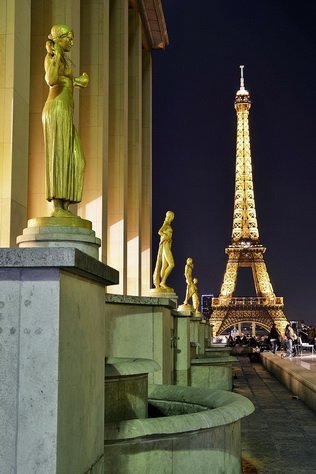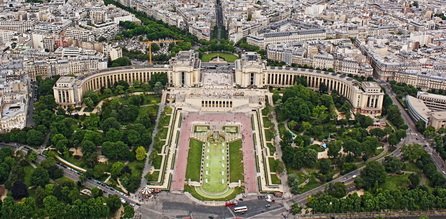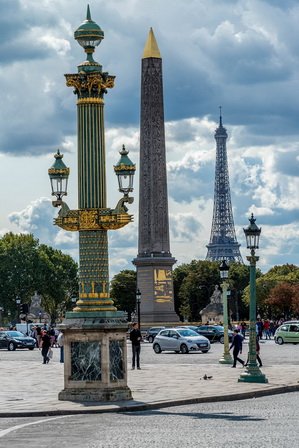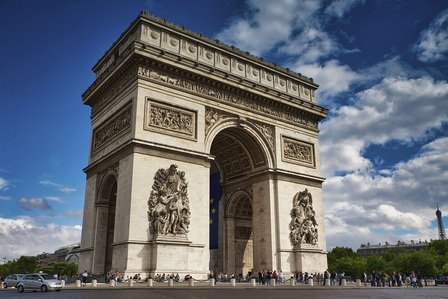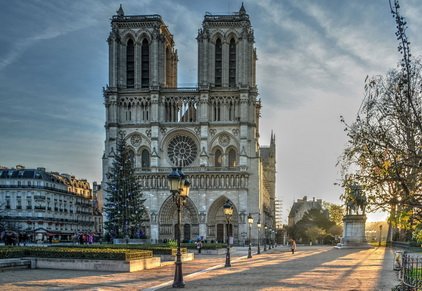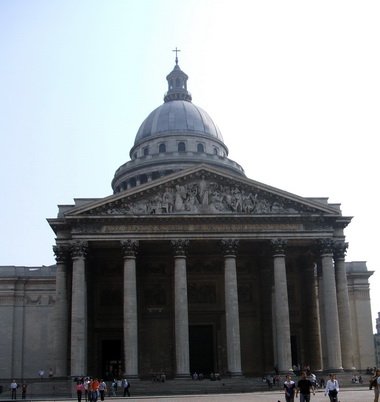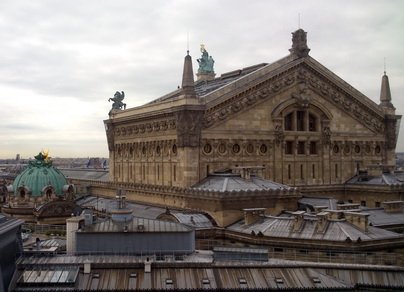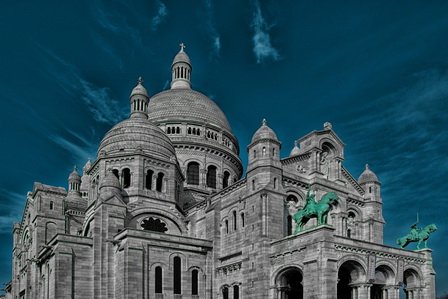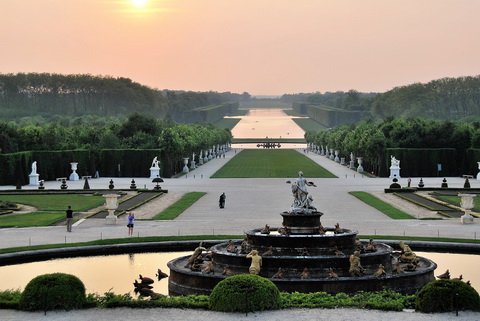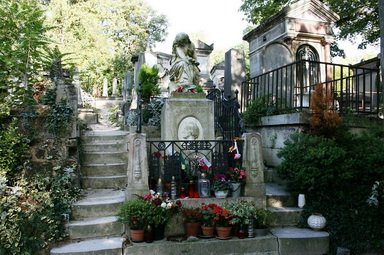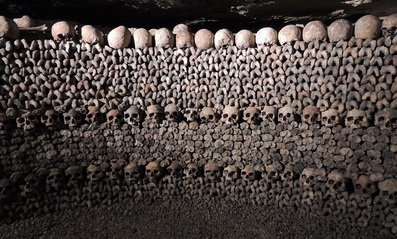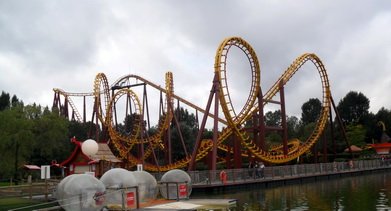Main attractions
Along the Seine river – Eiffel Tower to Notre Dame
1 The Eiffel Tower – 2 Trocadero Square area – 3 Champs de Mars & Military School – 4 Les Invalides (Napoleon’s grave) – 5 Place de la Concorde area – 6 Elysium Fields & Arc de Triomphe – 7 Louvre & Tuileries Gardens – 8 La Cité & Notre Dame Cathedral
1 Eiffel Tower
The Steel Lady is towering over the city since 1889 and the times of the World’s Fair. At first, it had as many followers as haters. They planned to deconstruct it after only 20 years. For 40 years it had been the tallest building in the world as well.
A few years ago, it was separated from the Field of Mars (Champs de Mars) with a barrier. Only after crossing this “security line” you can buy tickets and enjoy the views from the proximity. Two legs have stairs, two – elevators. Everything comes together at the top, which is almost at a height of 300 meters. There are 3 platforms, and you can profit from the views on each of them. The construction weighs almost 7 tons and it is mostly steel. It was ingenious at the time – huge segments all put together.
Today it also takes your breath away, although the reasons are different. It is huge, visible from afar and its shape has become the symbol of Paris. If you want an attraction that you don’t want to miss, this is the one. It would be good to eat something in her shadow at least… if you don’t want to enter because the crowds scared you off. You can also let yourself be mesmerized by the colorful, blinking lights it is covered with in the night – the city in the night changes its character completely.
2 Trocadero Square area
On the other bank of the Seine river, opposite the Tower, you can find some shade among the trees and the fountains. This is perfect on one of these hot days in the city. Trocadero is a code-name for various attractions you can find in the vicinity.
You pass between the wings of the Chaillôt Palace to find yourself at the platform. The view gives you the fountains, Varsovian Square, and the Eiffel Tower. It is a popular place, liked by Parisians who enjoy a 5-minute break in here. There is an Aquarium inside the hill – it attracts quite a few families. Even Chaillôt Palace has a theatre in the basement. The upper floors hold the Maritime Museum and Architecture Museum. The palace was itself built for the World Fair as well (this time, in 1937) and, thankfully, it wasn’t deconstructed. Two wings are connected by an empty square, adorned by golden figures made of bronze. It is the very spot of the most famous and recognizable postcard-pictures and selfies: the row of art-déco-like statues and the Steel Lady in the distance. If you want to have this picture – you must come here.
3 Champs de Mars and the Military school
The green fields at the field of the Eiffel Tower are called Champs de Mars (Fields of Mars). The name was given after the god of war who was taking care of his soldiers and looked at how they practiced there. He is doing it still – the Military School standing at the end of the green area is still in function.
These fields are one of the biggest parks in Paris, but you won’t find many trees there. Therefore, I do not recommend this place in the summer heat. Picnics are very common here and you can walk the alleyways and enjoy the sights. You can grab Eiffel Tower into your hands there – at least on the photo or see how the word “peace” looks like in all the languages of the world (the Wall of Peace).
Leave the Tower behind you, follow the Fields of Mars till they end and you will find the Military School. It was king Luis XV that funded it in the XVII century. Napoleon himself was studying there.
And if you feel like it, you can walk on foot to Les Invalides (Napoleon’s grave). It is only 15 minutes from there.
4 Les Invalides
This very ambitious project is the child of King Louis XIV. It was home to injured soldiers since 1676. On 12,5ha they had their rooms, workshops, a church, and a hospital. Today there is a museum and the Ministry of Defence.
But then… it made the king quite popular. The soldiers didn’t feel abandoned, they felt needed again. The absolute power profited from this trust and faith. They made shoes, did some needlework, made some small, handcrafted objects. They had home… after all the horrors they had experienced.
In later times the cannons were added – they were protecting the palace from the side of the river. They stand over the original moat and they came from Austerlitz. It is not the only souvenir of the small general. Napoleon himself sleeps here today, under one of the biggest church cupolas and in a marble sarcophagus. You can visit only him alone without visiting the museums, that are situated in other parts of the Invalides Complex.
Go for a short walk to the Seine river. You will pass the beautiful Alexander III Bridge (C), and you can visit the great and small Palaces (Grand Palais and Petit Palais). This short journey will lead you straight to the Elysium Fields.
Near Les Invalides, there is also the Rodin Museum of Art or the Polish Embassy – if you happen to have lost your passport.
5 Place de la Concorde and it’s surrounding
It is a square like many others. You are sure to pass it on numerous occasions so it will be good if you know a few words about it.
It had many names over the years. It started as Louis XV Square. The Great Revolution killed all the kings even the stone ones. A guillotine replaced the statue, and the name was changed to Revolution Square. After this difficult period, the authorities were looking for something acceptable by all the parties… “the agreement, the consent” felt right. An obelisk – a gift from the Egyptian government was put in the middle – the same problem, it seemed the least controversial. It came from the Luxor temple and is guarded by two fountains, adorned by personifications of the seas and rivers of France. No connections to the government or to the monarchy.
It is an extremely important junction. On the one side – it opens to the Champs d’ Élysées, on the other – the Tuileries Gardens and the Louvre Museum. In the North, you can see St Margaret Church (D). On the opposite side is the river and some sort of a mirror image – but instead of the church, there is the National Assembly (headquarter of the part of the parliament).
The square looks beautiful at night, lit by the old-school lamps. It is a part of the historical line, going from the beginnings at the Louvre Museum area, through the Arc de Triomphe – marking the beginning of modern times; to the Arc in the La Defence district (A) – the monument of glory and hope for the future.
6 Elysium Fields (Champs Élysées)
The 2km-long alley is one of the most expensive in the world. There you can find luxurious car salons, one of the best clothes shops in Paris, great restaurants, Lido cabaret and more.
Once it was simply a road leading to the Palace of Louvre. Today every element of this road is clearly marked. The entrance through Place de la Concorde has two columns with the Marly horses. The gardens that welcome you first, allow people to catch their breath… The whole project was created by Andrée be Nôtre in the XVII century – the Tuileries Gardens were a part of it. Later some modern parts were added – two Palaces -big and small (Grand and Petit Palais), built for the World Fair. The whole project looks spectacular.
The ambiance of the Fields changes at some point. The park gives way to typical Parisian tenements. Once, ladies from these houses were going for a walk in the green alleys of the Elysium Fields, showing off their new dresses and hats. Carriages with horses were being pulled up – the hill was quite steep then.
Today there are no more hats, and the top of the hill is adorned by the Triumphal Arc or, more commonly known, Arc de Triomphe (6a). It is another of the city’s symbols. Designed by Napoleon Bonaparte, the general was supposed to pass through it at the head of his armies. He did so, but only after his death, in a coffin – when he was transported to Les Invalides for his final rest. The Arc gives us the names of his commanders and the locations of his numerous battles (Polish ones too). Inside the Monument, you will find a small museum and a viewing platform. From above you can see why the roundabout/square was given the name “star” – Place d’Étoile means “the Square of a star” (check the road’s cobbles).
At the feet of the Arc, there is the tomb of the Unknown Soldier – dedicated to all those who died, not only in the Napoleonian wars. It is often visited by Polish delegations, both official and tourists.
7 The Louvre and Tuileries Gardens
The fortress of the French kings stands next to the river Seine since 1190. From that day onward each new king was adding something new to it (and there were over 20 of them) – corridors, rooms, garden areas. The place has over 135000 square meters of the surface area now. It was big enough so that King Henry IV was organizing the true fox-hunts there for himself and his children.
By XVII century Louvre was forgotten because the court moved to the Palace of Versailles. Soon, the government of the French Revolution decided to turn the abandoned corridors into a museum. The first artifacts belonged to the private collection of King Francis I. It grew rapidly, especially during the times of Napoleon. A lot of things were not returned to where they were found. The Egyptian wing is said to be as good as the one in Cairo. Apart from that, you will find here Victory of Samothrace or Venus de Milo.
The paintings are the most precious. They show you their evolution until the XIX century. At one point there were so many of them, that they were moved to a newly created Orsay Museum (today the contemporary art, after the first half of the XIX century can be seen there). The pearl of the Louvre is the Mona Lisa by Da Vinci.
Today you can find all sorts of things on the museum grounds: restaurants, coat rooms, souvenir and book shops, or mini benches to sit on. The only thing that you will need inside is the time and strength – somehow you always run out of both. But… no surprise there. Louvre gives you about 10% of all the artifacts that they have. The total number is said to be 350000. Even this small amount gives you a headache or… the Stendhal syndrome (faintness and heart palpitation due to the art overdose).
For those who have already visited the Great Pyramid and have found the small, inversed one underground, there are the gardens to rest in. Jardins de Tuileries was designed by the fame of the XVII century – Andrée le Nôtre. It was in the times when the court with the glass pyramid was closed by the fourth wing – the Tuileries Palace. It was destroyed during the revolution of 1871 and so today you can go straight from the pyramid to the gardens. There are fountains, nice restaurants, and a few benches to rest after a long day. The small, square building in the gardens houses the Musée de l’Orangerie with Monet’s masterpieces – you can visit for the price of a ticket.
You can also take the stairs leading down, they are next to the Arc du Carrousel and go to the “belly” of Rivoli Street. There, underground, you will find more shops and restaurants, the upside-down pyramid, and another entrance to the Louvre.
From the museum and the gardens, it is only a short walk to Pont des Artes also known for the lovers-locks once hung there. On the opposite side of the museum, you can find the Vendôme Square (E) – Frederic Chopin once lived here. You have all the possible options… you are after all in the center of Paris!
8 La Cité – the island of the Notre Dame Cathedral
You could argue where is the true center of Paris, but you cannot argue with where it started. This island is a place where the Celts settled and created a place later known as Lutetia. They are said to be conquered by the Romans, which renamed the village Parisium.
The island gave the feeling of security – here is where the first castle/fortress of Paris was built. It is now called Conciergerie and is a museum. One of the things you can see there are the rooms where Queen Antoinette had been waiting before her execution. Two, massive towers – very characteristic of this building, can be seen from the side of the river/Louvre side. Inside the complex, there is also a place called Saint Chapelle. It was built by King Louis IX the Saint using stones and an enormous (for those times) amount of glass. Her main purpose was to be the home to the saint artifacts brought from Jerusalem – the Crown of Thornes and some parts of the skull of John the Baptist.
Part of the fortress is called the Palace of Justice. Everything was once connected but today was divided and given different functions. The castle was enormous – going from one shore of the island to the other, but today there is no need for it. This particular part became the seat of the Justice Department, but we cannot forget that it housed the kings of the Franks (Merovingian Dynasty) from the V century. The whole complex was eventually left for Louvre and then Versailles.
La Cité has one other important monument – it is the Notre Dame Cathedral. The church of Quasimodo, the witness of marvelous royal weddings and a place visited by Pope John Paul II. It stood there constantly for 800 years until a great fire of a few years back almost destroyed it. Now we are all awaiting its reconstruction.
9 Pantheon and Luxembourg Gardens (9a)
Louis XV’s basilica was supposed to be constructed on the very spot, where Saint Genevieve prayed for the Huns to leave Paris at peace. She succeeded and later so did the king. The church was beautiful, monumental and a good copy of the original from Rome.
Nevertheless, it was short-lived. Soon the function was changed – everything connected to monarchy was erased. Pantheon became a mausoleum of the famous French people. It is possible that it would have been forgotten, especially after the French Revolution. But the funeral of Victor Hugo in 1885 changed everything. From one fame to the other, until today. You can meet there Rousseau and Voltaire, Alexandre Dumas or Marie Currie Skłodowska. At the entrance, you read “to its famous people their grateful country!”
It is only a short walk from the Pantheon to Sorbonne (L). You will find the building in between the smaller streets of the Latin District. Look for a building with a telescope tower. You cannot enter if you are not a student or an employee. But you can bow to all the famous people that had once thought and studied here.
Before the building came to be, this area was an empty hill. Students sat on the bales of straw in the fields or meadows and slept in the nearby taverns. There was no place for them… and then the first college was built in the XIII century.
Not far from Pantheon and Sorbonne are the Luxembourg Gardens (9a). The palace inside bears the same name. It was a gift to Marie de Medici in the XVII century. It was supposed to lessen the feeling of longing the queen felt. The palace is the spitting image of Palazzo Pitti in Florence, Tuscany. There is also Medici Fountain in the gardens and… a statue of liberty! It is like a gallery in the fresh air. The palace is a seat of the parliament since 1800.
10 Opera Garnier
The monument of art, lux, and pleasure – this is what Charles Garnier, the architect, told about it. He built it for Napoleon III in the middle of the XIX century. It is one of the most famous operas in Europe.
Inside there is only a place for 2000 guests, but the splendor delights and the fame of the place make people visit. Crystal chandeliers, colorful marbles, eclecticism, reliefs, and golden décor. Everything spiced by the legend of the Phantom of the Opera.
Few steps away you will find the Lafayette Gallery (F). It may be a shopping center, but it is just as magnificent as the opera. All main brands under an enormous cupola and a special bridge which allows you to capture its beauty in a picture… Not many tourists know that there is a viewing terrace at the top – completely free of charge (the above photo comes from that place).
11 Montmartre
A mythical hill, a place where Saint Denis was killed by the Romans, a district of the poor, the mecca for various artists, the Red District, the kingdom of the thieves… a place that we love.
There is no other place where history lives next to the monuments, where the food is delicious and where no one wanted to live once… Today we pass by the old apartments of Pablo Picasso and Dalida. Can you imagine?!
Pigalle Square (H) is known thanks to the roasted chestnuts. Although you won’t find them there as often as you would like. But the Red District is alive and well! Especially in the evening, with the neon lights of the sex shops and the doors of the sex Museum open.
La Goulue is no longer dancing in the famous cabaret. But the traditions of Moulin Rouge (G) are still there. You can buy a ticket to see the show or take a picture outside. There is a ventilation vent there and you can make a true Mayan Monroe-style shot.
For the views of the city, you go to the top of the hill – using the straight line of stairs or the labyrinth of streets. The artists of the XVIII and XIX centuries lived somewhere over there. Edith Piaf sang at one of these corners. Restaurants look inviting, the shops and galleries are mesmerizing. There is a “Square of Painters” (Place de Tertre) at the top -you can order your caricature there. As they say “the cherry on a top” is the Basilica of the Sacred Heart (Sacre Coeur). It was built in the XIX century for the money given by all the citizens. Yet another symbol of Paris. Small green park space is at her feet – good to rest and great because it doesn’t spoil the views.
So, what is the reason you come to Montmartre – sightseeing, entertainment or food? Each one is worth it.
12 Versailles
The palace complex called Versailles was for a moment the capital of Paris. Louis XIV, the Sun King, wanted it to be the symbol of his absolute, god-given power. He turned his father’s hunting lodge into a monument surrounded by a 43-kilometer wall. It consists of the main palace and two, smaller ones. The whole edifice has 700 rooms!
You don’t have to visit them all, although the main building is quite popular with the tourists. You can see the life of the royal family in their best times. The rooms of the king and the queen, their private chapel, and the famous Gallery of Mirrors.
For the ones looking for a place to rest – there are the royal gardens. There are many paths, all following the main pool of the water, where boats were swimming in the past. the Grand and Petit Trianons – private palaces of the king and queen are there as well. They were hiding there when the court felt like too much. You won’t be able to walk through it all – the gardens turn into the royal forests. Think of it as a museum in the fresh air – with 50 fountains and pools and 400 statues.
If you have time and strength you can wander around Versailles town. You can eat in a restaurant, rest, or find a train station and get back to Paris. If you do decide to go for a walk keep in mind that the whole place was created only because the king moved here. The most important ones from the court could live in the palace, but something had to be arranged for all everyone else.
13 Père Lachaise Cemetery
The necropolis wasn’t popular at its beginnings in 1803. It was too far from the city. It was 15 years later, that the city got the idea to bury Moliere, La Fontaine, Albert and Heloise here… and it started. The place became a site for famous people. It was big enough to make great mausoleums and the place is quiet.
When you walk among the trees today, looking at the blackened pieces of art, you can forget you are at the cemetery. Polish people come here for Frederic Chopin. The composer has two tombs – one here and the other is in Poland. He came to Paris when he was 20 years old. Europe was his place of work; he came from Poland but died in France. And so his heart is in the Polish capital and the rest here, in Père Lachaise.
Don’t forget to check out the tomb of Jim Morison, Oscar Wilde, or the one belonging to Edith Piaf’s family. You can also simply enjoy a stroll there.
14 Montparnasse Tower and the Catacombs (14a)
The black monolith was built in 1973 and it shares the story like Eiffel Tower – many people hated it. Besides the practical function, it is a real treat for those looking for panoramic views. You get the 360°-panorama from a 210-meter-high terrace and when the weather is good you can see as far as 40km. What is most important – you cannot see the black monolith standing on top of it!
Not far from the tower, on the other end of the Montparnasse Cemetery, lies the entrance to the legendary Catacombs. For centuries, the building material used to construct Paris was taken from beneath it. In the XVII century, the quarries were turned into an ossuary. The mass graves’ remains from the numerous cemeteries were transported here under the cover of the night. The underground corridors can give you goosebumps. They are full of bones and the walls made of skulls. Some movies were even filmed there (Catacombs 2007, As above so below 2014).
You can only visit with an organized tour and a ticket reservation. If you plan a visit -make it in advance – it is recommended.
15 Parks for small and big children
Let’s face it, we are all children, even when we are all grown up… we sometimes let this part, hidden deep in our heart, go out. Having children makes it all the easier (they are the perfect cover)!
Paris has some of the most amazing places that will make your heart run a bit faster – either with excitement or the pure joy of looking at something beautiful.
Disneyland is the most know amusement park in the vicinity. It has been welcoming guests since 1992 and grew much since that date. Apart from the classic Disney part, there is also the Warner Bros studio, with some attractions for older kids. You have everything there – flying cups and the princess’s castle loved by every girl. There is a Pirate Grove and Ghost House for young adventurers. And the roller-coasters are perfect for everyone, although everyone loves the Buzz shooting gallery as well.
The Asterix and Obelix Park is the later addition. It is the French answer to the American dream machine. Two famous Gauls are embedded in the history, minds, and hearts of every French. The comics series are known all over the world, not to mention the movies. Disneyland may be better connected – there is the RER directly to it, but this one has a dedicated bus service. And, what is more important, it may be better for older children. The attractions seem to be more exciting, but the height limits are more strict. There are things for smaller kids, but definitely less than in Disneyland. But they get to see dolphins and seals, since the Asterix Park has a pool with them, with multiple shows throughout the day.
If you are looking for something close by, and short, there are a few things in Paris itself. The Aquaboulevard is an aquapark with a Minigolf Court next to it. You can relax, swim, play in the enormous wave or check out those holes – just for a day or a few hours. The Aquarium, hidden under the trees of the Varsovie Square is a place to see turtles and pet a shark. It is something short, to relax for a moment while looking at the mesmerizing fish. If you want something equally short – try the wax museum (Musée Grevin). For those looking for some modern amusement ideas – go to the City of Science and Industry in Villette Park. It is located on the green, calm grounds of a park but shows you the ingenuity of the human mind. You will love it.
As hopefully, you will love Paris. Like every capital in the world – the rush you find there can scare you off, but it will be only for a second. Let yourself breathe the air of this magical place full of memories, emotions, love, light, sometimes blood, but eventually – a mixture of human creativity. Paris was called the capital of Europe for a while… and with a good reason.

